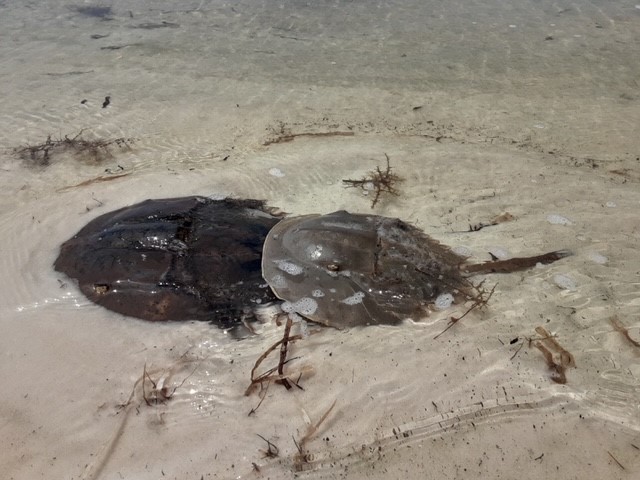Another creature that was once common in Pensacola Bay, declined, and is trying to make a comeback is the horseshoe crab. Many know about the shallow area in the center of Little Sabine, but you may not know that it was once an island that the locals called Horseshoe Crab Island because of how common the animals were there. Like some other animals in our bay, they disappeared. In recent years they have been spotted in several locations around the bay area. Florida Sea Grant began to track these locations.

Photo: Bob Pitts
Horseshoe crabs are actually not crabs at all. Though they are in the same phylum as crabs (Arthropoda) lacking antenna they are more closely related to spiders and scorpions. They are one of the most ancient animals still existing on our planet. There are fossils of them at least 400 million years old, predating the dinosaurs. There are four species still in existence on the planet including the one found along the east and Gulf coast of the U.S. – Limulus polyphemus.
They seem to be abundant in the Big Bend region, but we did have populations in this area as well. Horseshoe crabs are most associated with estuaries but frequent the open Gulf of Mexico as well. They plow through the seabed searching for small invertebrates to eat. Like all arthropods, when they grow, they molt their old exoskeleton (shell) to grow a new one. These empty molts are thin, tan in color, and are often found on beaches.
When it is time to lay eggs, the larger females begin to head to the beach. They do this during the spring high tides of fall and winter – which occur during the full and new moons. The smaller males will gather near shore in hopes of fertilizing her eggs when she lays them. The first leg of the males is a modified hook which they use to hold on to the female’s carapace (shell) and ride her into the beach. Only one male can do this so the remainder will follow and are called satellites. Within 30 minutes of high tide the females will come shore and bury her eggs in the sand near the waters edge. The males scramble to be the one to fertilize them. The fertilized eggs incubate until the following spring tide (about two weeks) and then hatch into miniature versions of the adults.
It is hard to believe that an animal that outlasted the dinosaurs, and other catastrophes seen on our planet over the last 400 million years, would be declining now – but they are. The reasons are numerous but include lack of suitable nesting beaches. Ocean Hour, a volunteer group who cleans beaches each week in our area, found a female in a rip-rap pile searching a seawall/rock ladened shoreline for some place to lay eggs. There were beaches south of this location that could be suitable and hopefully she found them. There is a commercial harvest for horseshoe crabs in the Mid-Atlantic states. Their purpose is not food but bait for eels, which are prized as food there. They are also collected for their blood. Horseshoe crab blood is not iron based, as our is, but copper, and this produces a blood that is blue in color. But it is not this that people are interested in, it is an enzyme that congeals with bacteria called Limulus Amebocyte Lysate (LAL). Its reaction with bacteria can be used to test the sterility of medical supplies used in medical procedures to save lives – maybe yours. The horseshoe crabs are bled for this compound and then released. Most make but some do not survive.
Commercial harvest of any kind has not happened in the Pensacola Bay area. The most probably reason for the decline here was environmental. The bay has suffered since the 1950s with development and industrial discharge. Water clarity became poor, seagrass declined, and many other creatures declined as well. Over the last few decades there have been improvements in estuarine habitats within the bay and happily, people are seeing horseshoe crabs again.
The Florida Fish and Wildlife Conservation Commission (FWC) has a tagging program to monitor horseshoe crabs in our state. However, the tagging program focuses on large aggregations of horseshoe crabs at their nesting beaches. Though we have volunteers who have been searching for nesting beaches over the last couple of years, we have not found any yet. If you are interested in volunteering for the Horseshoe Crab Hunt contact Rick O’Connor at the Escambia County Extension Office.
 2
2
